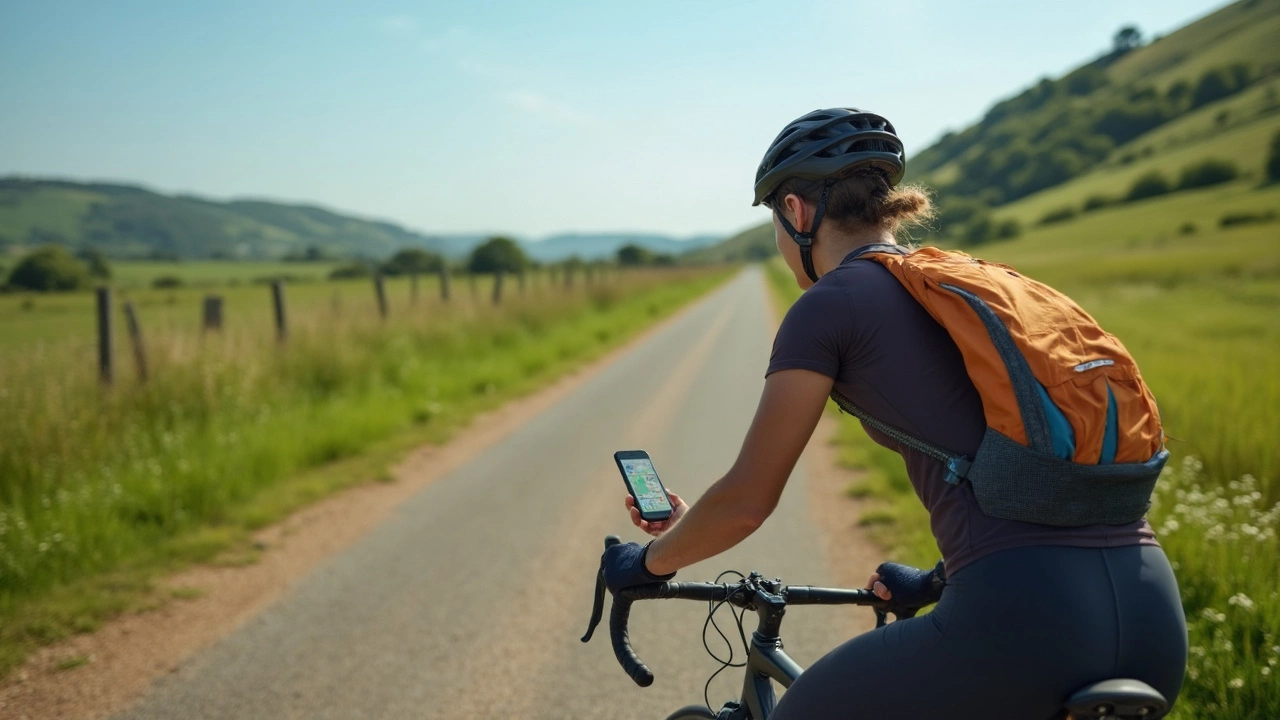Can You Use Google Maps Offline for Cycling?
 Apr, 8 2025
Apr, 8 2025
Did you know you can use Google Maps offline even when you're cycling? Yeah, it’s a game-changer for those 'no-signal' zones and remote trails. Imagine not having to worry about losing your way when the bars drop, right?
First things first, before you hit the road, it's crucial to download the maps you need. Just zoom into the area while you’re online and hit that download button. Voila! Your map is now with you, ready to be your trusty guide.
Wondering about navigation without Wi-Fi? No sweat. The GPS in your phone doesn’t need internet to pinpoint your location. So if you've got the route saved, you’re pretty much sorted.
- Google Maps Offline: The Basics
- Downloading Maps for Cycling
- Navigating Without Wi-Fi
- Tips for a Smooth Ride
- Taking Your Cycling to the Next Level
Google Maps Offline: The Basics
Using Google Maps offline is like having a secret weapon in your pocket, especially when cycling through areas with spotty internet. When you're prepping for a ride, it’s handy to know what you need to make offline mapping work for you.
First off, you need the Google Maps app. It’s your gateway to having the map magic wherever you go. The key step is downloading the areas you plan to explore. It’s best to do this while connected to Wi-Fi, not just to conserve data but also because it's typically faster.
Here’s a quick way to download:
- Open the Google Maps app on your phone.
- Search for the location — be it a specific city or a broader region.
- Tap the name or address at the bottom and press the 'Download' option.
- Select the area you need and hit 'Download'. Easy, right?
Once downloaded, these maps don’t expire overnight. They can last up to a year without internet, and Google even sends a reminder when they’re about to expire so you can update them.
Remember, while you’ll have the maps, some features like traffic data and alternative routes might need a data connection. So, if you’re venturing into the wild, plan your routes accordingly.
This offline setup is pretty nifty. It ensures that cyclists have a reliable way to navigate without constantly relying on cell service. It makes biking in unfamiliar areas less stressful.
Downloading Maps for Cycling
Alright, let's get into the nitty-gritty of setting up Google Maps offline for your cycling adventures. It's super handy to have Google Maps offline when you're pedaling through areas with dodgy reception or if you just want to save some data.
First thing you gotta do is open your Google Maps app while you still have internet access. Search for the city or area you’ll be biking through. Once you find it, make sure to zoom out enough to cover the full route you plan to take.
- Tap on your profile picture or initial in the top right corner.
- Select "Offline maps" and then "Select Your Own Map."
- Adjust the map to fit your desired biking route within the rectangle.
- Hit "Download" and let it do its thing; it’ll save right onto your phone.
Trust me, you’ll thank yourself later when you hit those signal dead spots. One clever tip is to check the storage space left on your phone because these map downloads can be a bit space-heavy.
While you're navigating under the open sky, remember that offline navigation doesn’t provide real-time traffic updates or alternate routes. But hey, for cycling routes through scenic or remote paths, this approach can't be beat!
If you're doing a route that covers a lot of areas, download sections beforehand to make sure you're not caught off guard. Always have a backup plan so your ride remains smooth and fun, even when you're disconnected from the web.

Navigating Without Wi-Fi
So, you've got your Google Maps offline, but you're wondering how to actually navigate without Wi-Fi? It’s simpler than you’d think, thanks to the wonders of GPS! Your smartphone's GPS can track your location without needing any data connection; it’s like magic but without the rabbit or hat.
Here’s how you can make the most of this offline navigation:
- Save Your Maps: Remember to download maps while you still have Wi-Fi or a good data connection. Google Maps allows you to save large areas, so don't skimp out. Cover all the places you plan to ride through.
- Location Tracking: Your phone's GPS pinpoints your exact spot. Even if the internet decides to disappear during your ride, just tap the blue dot on the map to keep track of where you are.
- Route Planning: Before going offline, set your destination. Although you won’t get any live traffic updates (bummer, right?), your pre-planned route remains intact and visible.
- Visual Cues: Offline maps don’t provide turn-by-turn voice directions, but you can use the visual path on the map. This means paying more attention to road signs and the actual route on your map.
Quick tip: Always take a portable charger with you, because while the GPS doesn’t gobble up data, it can eat up your battery like Max does with his treats.
Tips for a Smooth Ride
Having Google Maps offline is just the start. To really make your cycling journey seamless, consider these practical tips.
First, make sure your phone's fully charged before you start your ride. Last thing you want is a dead battery, leaving you out in the middle of nowhere.
“Failing to prepare is preparing to fail.” - Benjamin Franklin
Yeah, Frankie wasn’t thinking about bikes back then, but it fits!
Here’s a handy list to keep your ride hiccup-free:
- Download Areas in Advance: Keep your plans flexible, but download maps for broader regions. You never know when an unexpected detour might come up.
- Use Battery Saver Mode: Turn on battery saver on your phone to get the most out of your device during the ride.
- Plan Break Points: Pick spots on your route for rest, especially long rides. Look for nearby cafes or parks, useful for refueling and checking your directions.
- Update Maps Regularly: Ensure your offline maps are up-to-date. Even subtle changes in routes can make a huge difference.
The table below shows an example of battery usage with apps during cycling:
| App | Typical Usage Time per 100% Battery |
|---|---|
| Google Maps | Approx. 4 hours |
| Strava | Approx. 5 hours |
It's not just about maps; carrying a small portable charger can be a lifesaver. And don’t forget to keep your phone in a safe, secure spot—you don’t want a fun ride turning into a frantic search for a dropped device.
Lastly, familiarize yourself with offline navigation features before you set off. Test it around your neighborhood, so you’re comfy with how it works when the connection drops.

Taking Your Cycling to the Next Level
Alright, you're all set with your Google Maps offline setup, but how about stepping up that cycling game? There's a ton you can do to make your rides not just about getting from point A to point B, but also about having an epic journey.
Let's start with planning. When you're using offline navigation, you're free to explore without fearing you'll get lost. Consider exploring less-traveled paths. They're often more scenic and offer a bit of quiet time away from the hustle and bustle. Check out routes in advance to see what might catch your fancy.
Now, if data is your thing, track your rides with a GPS app. You can analyze how far you've gone, your speed, and even your elevation. Apps like Strava sync effortlessly with maps, letting you find popular cycling hotspots.
Want to make things social? Join local cycling clubs. Many of them organize group rides and have some great tips on cycling routes. It’s a great way to make new friends and push yourself a bit harder with some friendly competition.
- Biking GPS: Invest in a good cycling-specific GPS. The battery life is better compared to phones, and they’re built to withstand more bumps and rough weather.
- Offbeat Paths: Make it a weekly challenge to explore a new area or trail you haven’t ridden before. Who knows what hidden gems you might find?
- Gear Up: Get those comfy cycling shorts. They're a game changer for longer rides, trust me.
And hey, while you're at it, consider participating in local cycling events or races. They’re fantastic for gaining experience and testing your skills under different conditions. You’ll be surprised how much offline navigation technology can contribute, keeping you on track without any internet stress.
With these steps, you're not just cycling; you're embarking on a new kind of adventure every time you hop on the bike. Happy biking!